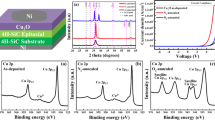Abstract
We report enhanced thermal stabilities of nanostructured Cu films containing insoluble tungsten carbides prepared by sputter deposition. Tungsten carbides in the form of W2C are present in the supersaturated solid solution of Cu, as confirmed by x-ray photoelectron spectroscopy, scanning electron microscopy, and x-ray diffraction analyses. Focused ion beam analysis revealed that the films are thermally stable during annealing when they are in contact with Si without a diffusion barrier, and the copper silicide was not formed up to an annealing temperature of 400 °C. Leakage current characteristic evaluation on SiO2/Si metal oxide semiconductor (MOS) structure also revealed the superior reliability of Cu with a dilute amount of tungsten carbides, indicating their usefulness in advanced barrierless metallization applications. The films with higher amount of tungsten carbides exhibited good thermal stability at high temperatures and could be rationalized as a consequence of a refined grain structure together with the strengthening effect of W2C.
Similar content being viewed by others
References
B. Li, T.D. Sullivan, T.C. Lee, and D. Badami: Reliability challenges for copper interconnects. Microelectron. Reliab. 44, 365 (2004).
L. Sun, J-C. Fouere, T. Sammet, M. Hatzistergos, and H. Efstathiadis: Spectroscopic ellipsometry (SE) and grazing x-ray reflectometry (GXR) analyses on tungsten carbide films for diffusion barrier in copper metallization schemes. Thin Solid Films 455–456, 519 (2004).
S.J. Wang, H.Y. Tsai, and S.C. Sun: A comparative study of sputtered TaCx and WCx films as diffusion barriers between Cu and Si. Thin Solid Films 394, 179 (2001).
K. Banerjee, S.J. Souri, P. Kapur, and K.C. Saraswat: 3-D ICs: A novel chip design for improving deep-submicrometer interconnect performance and systems-on-chip Integration. Proc. IEEE 89, 602 (2001).
P. Kapur, J.P. McVittie, and K.C. Saraswat: Technology and reliability constrained future copper interconnects—Part I: Resistance modeling. IEEE Trans. Electron Devices 49, 590 (2002).
J.P. Chu, C.H. Chung, P.Y. Lee, J.M. Rigsbee, and J.Y. Wang: Microstructure and properties of Cu-C pseudoalloy films prepared by sputter deposition. Metall. Mater. Trans. A 29A, 647 (1998).
J.P. Chu and T.N. Lin: Deposition, microstructure and properties of sputtered copper films containing insoluble molybdenum. J. Appl. Phys. 85, 6462 (1999).
J.P. Chu, C.J. Liu, C.H. Lin, and S.F. Wang: Characterizations of superhard Cu films containing insoluble W prepared by sputter deposition. Mater. Chem. Phys. 72, 286 (2001).
C.J. Liu and J.S. Chen: Low leakage current Cu(Ti)/SiO2 interconnection scheme with a self-formed TiOx diffusion barrier. Appl. Phys. Lett. 80, 2678 (2002).
K. Barmak, A. Gungor, A.D. Rollett, C. Cabral, and J.M.E. Harper: Texture of Cu and dilute binary Cu-alloy films: impact of annealing and solute content. Mater. Sci. Semicond. Processing. 6, 175 (2003).
K. Barmak, A. Gungor, C. Cabral, Jr., and J.M.E. Harper: Annealing behavior of Cu and dilute Cu-alloy films: Precipitation, grain growth, and resistivity. J. Appl. Phys. 94, 1605 (2003).
C.H. Lin, J.P. Chu, T. Mahalingam, T.N. Lin, and S.F. Wang: Thermal stability of sputtered copper films containing dilute insoluble tungsten: A thermal annealing study. J. Mater. Res. 18, 1429 (2003).
C.H. Lin, J.P. Chu, T. Mahalingam, T.N. Lin, and S.F. Wang: Sputtered copper films with insoluble elements for Cu metallization: A thermal annealing study. J. Elect. Mater. 32, 1235 (2003).
J.D. Oxley, M.M. Mdleleni, and K.S. Suslick: Hydrodehalogenation with sonochemically prepared Mo2C and W2C. Catal. Today 88, 139 (2004).
M. Ohring: Materials Science of Thin Film (Academic Press, Boston, MA, 1991), pp. 455–461.
Author information
Authors and Affiliations
Corresponding author
Rights and permissions
About this article
Cite this article
Chu, J.P., Hsieh, Y.Y., Lin, C.H. et al. Thermal stability enhancement in nanostructured Cu films containing insoluble tungsten carbides for metallization. Journal of Materials Research 20, 1379–1384 (2005). https://doi.org/10.1017/S0884291400087859
Received:
Accepted:
Published:
Issue Date:
DOI: https://doi.org/10.1017/S0884291400087859



